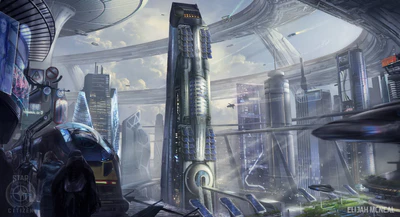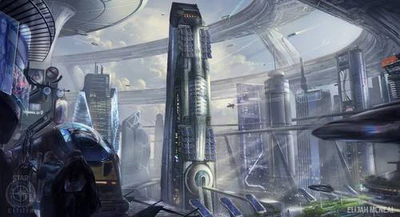Davien is best known as the site of first contact between Humans and the Banu. Discovered early in mankind’s extrasolar expansion, Davien was charted by Wendell Dopse and named after his father-in-law. The most unusual facet of Davien’s discovery was what it represented to the broader astrophysics community: contemporary science had predicted that no additional jump points would exist in the Croshaw system. When Dopse charted the jump to Davien, it meant that textbooks had to be rewritten and it ultimately lead to a flurry of advancements in jump scanning technology.
Davien itself was not seen as so interesting. A slight, orange Type K Main Sequence Star, Davien was immediately considered nothing to write home about by its original explorers. Four planets orbited the star, the second of which was a candidate (albeit not a top list candidate) for terraforming. The system held no exotic resource caches or strategic military chokeholds; it seemed destined to become a lightly-populated backwater star system adjacent to more developed areas of the Empire.
That all changed quickly in 2438. Vernon Tar, an independent navjumper, opened fire on what he believed to be another private spacecraft attempting to jump his meager claim in the system. The ship in question turned out to be a Banu merchantman and the unfortunate incident (which luckily did not lead to loss of life) became humanity’s first introduction to the Banu Protectorate. The UPE quickly established a military-led watch station in the system to take control of the situation, and the first interstellar treaty with the Protectorate slowly took shape. (The ultimate irony for all parties involved, not discovered for many years, was that Davien was not especially close to the Banu coreworlds; the ship originally engaged by Tar was a fugitive fleeing civilization.)
The result for the Davien system was electrifying. Every independent operator in the galaxy wanted real estate in the system, now set to become the jumping off point to trade with the Banu. With the potential for exotic materials, alien technology and more, the system was flooded with all forms of humanity, and Davien II developed into one of the more populated Human worlds in the galaxy. BabCo GeoBuilders, which had won a low-ball terraforming bid before first contact, was propelled up the stock market as the demand for hangars, habicubes and underground domes soared.
A large, battered and gray rock that is visually similar to Earth’s moon, Davien I makes a reasonable poster child for the concept of a useless world. Coreless and without any interesting minerals, there is absolutely no reason to set foot on the planet. In fact, there have been no recorded landings on Davien I since the initial system exploration mission determined that it could never be a candidate for terraforming.
Davien II, named Cestulus after terraforming was completed in the early 26th century, is the system’s inhabitable world. Cestulus has a very thin atmosphere and the majority of Human habitation is beneath its rocky surface: elaborate biodomes pump air from above ground into habicubes constructed to stack miles beneath the planet’s crust. The world has no particularly interesting resources and the bulk of its economy is associated with transport and shipping. Despite the distance from the Banu, the infrastructure that has sprang up on Davien has allowed it to become the so-called “gateway to the Eastern Empire.” Dozens of major cargo runs criss-cross the system, and the planet is dotted in spaceports with facilities to entertain and supply long-haul transport crews.
Jata is Cestulus’ most emblematic city, though not technically the world’s capital. Located underneath an everexpanding warren of air production facilities, the city is most famously home to Aegis Dynamics’ corporate headquarters and initial production facilities. The base primarily produces components rather than a particular ship design. More exotic resources are imported and the need is consistent. Beyond Aegis’ footprint in the city, the unique ‘open air’ underground cityscape has become symbolic of the Davien system as a whole.
For reasons not completely understood by sociologists, Cestulus became a flashpoint for political upheaval. In 2529, the feared economic collapse that accompanied the introduction of the Empire’s unified currency, UEC, lead to a bloody, two-week riot in the city of Jata. Only military intervention stopped the protest. In 2545 the planet was the site of terrorist bombings that left thousands dead, with bombs being planted specifically to collapse some of the planet’s more populated overground biodomes. These strikes kicked off a series of similar (and still unattributed) attacks across the UPE that lead to the adoption of Ivar Messer’s Prime Citizen plan. In recent years, Cestulus has become the adopted podium of everyone from Terran secessionists to anti-alien xenophobia groups.
Travelers are well-warned that owing to the system’s history of political upheaval, the Advocacy forces and local militia units in Davien are no-nonsense elites. Your cargo will be scanned when you enter the system, land, take off and exit. Waystations and well-equipped militia spacecraft are the rule here, and only the most advanced artificial holds and scanner blankets can possibly move contraband through Davien’s “galactic truckstop.” There is no humor for smugglers, even the most harmless varieties.
Davien III is a smog planet with an acid-based atmosphere. With no apparent resources worth the risk of establishing a protective enclosure colony, the planet remains uninhabited. Rumors do persist that Davien III is a dumping ground for troublemakers and others who find themselves on the wrong side of the region’s organized criminal syndicates. The planet’s pools of acid will quickly render any body (or spacecraft or most anything else) unrecognizable.
Davien IV is a beautiful but inhospitable ice giant. Owing to its orbit’s proximity to the system’s jump point out to Cathcart (the jump point used by that first Banu) and its very stable orbit, the 25th-century UPE military mission was established in Davien IV’s orbit. Today, the base is the Banu Friendship Museum, where visitors can learn an overly-simplified story of mankind’s interactions with the Protectorate. Few tourists are interested enough to make the trek to the system’s outer reaches, however, and the museum is constantly in danger of losing its funding.

